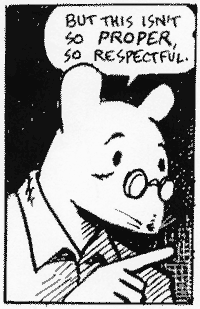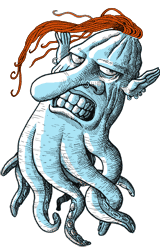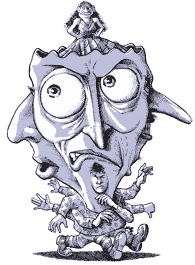[This post was originally posted on September 6, 2002. It disappeared from the archives at some point or other, so I’m now reposting it. –Amp]

The excellent legal blogger Sam Heldman writes “It’s easy to disprove the thesis ‘all daily strips with talking (incl. thinking) animals are pure genius’. (Garfield. QED.) But is it possible to disprove the thesis that ‘no daily strip without a talking (incl. thinking) animal has ever been pure genius’?”
I got into an argument with Scott McCloud about this years ago; Scott had made some sort of compendium of the important comics genres, and although he included “superheros,” he hadn’t included funny-animal comics. Yet if you consider artistic worth, funny-animal comics – Krazy Kat, Pogo, Mutts, the Barks Uncle Scrooge, the Gottfredson Mickey Mouse, Art Spiegelman’s Maus, and if you stretch the genre a bit Barnaby, Bloom County, Peanuts and Calvin and Hobbes – have been at least as important as superheroes in the history of American comics. Even my current favorite daily, the perennial exception-to-the-rule Bruno, has a cat that thinks aloud.

Anyhow, to answer Sam’s question, there’s a lot of non-talking-animal genius if you include soap opera and adventure strips. There were no talking or thinking animals in Terry and the Pirates, for example, or in Little Orphan Annie (I don’t think Sandy saying “arf!” counts). Truthfully, though… as brilliant as the classic soaps and adventures were, they also generally suffer from clichéd, stock characters. The best strips feature a level of humanity and characterization which the soaps and adventures strips – due, I think, to their extreme emphasis on plot – can’t match. I think Sam could argue that none of these arise to the “pure” genius level.
There’s Little Nemo in Slumberland, of course – but that’s a weekly, not a daily.
I’d argue that at its best, Polly and Her Pals is as good as any comic strip ever done – but Polly’s best was always the Sunday strips, not the dailies.
Some folks would argue for the original Dennis the Menace, but I’ve always thought Dennis was overrated (although undeniably beautifully drawn).
 Still, there is one strip – kinda halfway between being a gag strip and an adventure – which inarguably had “pure genius” in its peak years. And although I can’t say for certain, I don’t recall any talking (or thinking) animals. Thimble Theatre (which most folks think of as “Popeye”) is about as good as comic strips get.
Still, there is one strip – kinda halfway between being a gag strip and an adventure – which inarguably had “pure genius” in its peak years. And although I can’t say for certain, I don’t recall any talking (or thinking) animals. Thimble Theatre (which most folks think of as “Popeye”) is about as good as comic strips get.
There’s one more strip I’d argue for – the perennially-underestimated Doonesbury. It’s now past its prime, but at its peak (which lasted a couple of decades) Doonesbury was consistently fresh and funny, with excellent characterization and reasonably good drawing (Trudeau isn’t a natural at the drawing board, but he works hard, and has his own distinctive style). It doens’t rise to Pogo or Peanut’s level, but it deserves more credit than it generally gets.
I know there’s stuff I’m forgetting; I’ll probably get tons of emails pointing out this or that classic daily with no talking animals. But for now, I’ve gotta say – damn, Sam’s question is difficult to answer! The heirarchy of daily strip genres is now clear. All other daily strip genres must bow down (chanting “we’re not worthy! we’re not worthy!”) before the talking possums, kats and beagles.
(Edited long after the fact to correct my embarrassing reference to Sandy saying “woof,” when everyone knows Sandy mainly said “arf.”)




Pingback: ComicsPedia.com | Your best source for vintage comics!
I was going to say Doonesbury, and as a fan of the earlier strips (I’ve read most of the early 1970s strips and a fair amount from the late 70s to the millenium, when I became a daily reader)I don’t think its at all lost its edge.
But for Doonesbury, the question does present itself–do talking plants count?
I don’t get the category. Is it “strips without talking animals”, or is it “strips with animals that don’t talk”? If the former, then I’d definitely nominate Doonesbury. And I don’t know how underrated it is – it’s hugely popular and he did win a Pulitzer.
As for the art, Trudeau admits he’s farmed it out for years. He hasn’t actually drawn the strip for a long time. (There are others who’ve done this.)
David, in my opinion Doonesbury isn’t as sharp now as it was in, say, the 1980s, especially in the period following Trudeau’s hiatus. But I agree it’s awfully damned good now.
Keith, it’s not true that Trudeau doesn’t draw Doonesbury. He does detailed pencil drawings, which he faxes to his collaborator, who does the finished drawing in ink. I don’t know any cartoonist who would say that someone who does detailed pencils is not drawing his own strip.
I agree that Doonesbury has been enormously successful in the real world. But it’s not a strip I frequently here “comics literati” getting excited about. That’s what I meant by saying it’s underrated.
Finally, unfortunately, you’re right to say that farming out the art completely is a common practice. But in my opinion, it’s a practice that sucks. Cartoonists who find drawing their own strips too tiresome to do, should retire. (But let me repeat: Trudeau draws his own strip, so I’m not criticizing him at all when I say that.)
It’s not a daily strip, but how about “Dykes to watch out for”? It’s one of the better strips out there, in my opinion, and it has animals who never talk or otherwise act like anything other than animals of the species they happen to be. (Ok, technically it does have animals that talk, but they’re all of the species H sapiens.)
Well, Sam specifically asked about daily strips, so “Dykes” doesn’t fit the bill. But I think it’s an absolutely brilliant strip; probably the best soap-opera strip ever done.
I thought today’s Doonesbury was pretty good. Tell me that the scenario depicted hasn’t played out in the last 30 minutes somewhere in Iraq.
Isn’t dividing writing and drawing fairly common in the comics world? How does farming out the drawing differ from collaboration between a writer and visual artists?
Well, the main way it differs is that writing and penciling are both seen as making you a “creator” of the work, whereas an inker is seen more as an assistant.
What this means for comic strips is that it’s often considered unethical to have an uncredited person doing the writing or the pencils, but it’s not considered unethical to have an uncredited inker.
So it is mainly the crediting issue. A comic that was written by one person and penciled by another would be legitimate if properly credited, but is illegitimate if the penciler is not credited, and presumably especially so in the case where the project was originally a single person writing an penciling who then farms out hte penciling without credit. That seems like a fair thing to object to.
Barry – what about Boondocks before it got tired and died?
Heh. Dammit. And I was hoping to be the one asking whether talking plants counted.
-fred